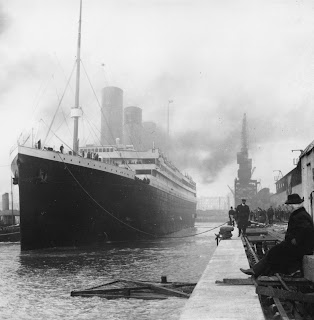Date: April 14-15, 1912
Deaths: over 1,500
Survivors: about 700
Boarded: 2,200
Interesting fact: Most people froze to death, not drown.
All second class children survived.
Lesson learned: No ship, no matter how big or well designed, is unsinkable.
On the night of April 14, 1912 Titanic, a British ship, was on her main voyage to New York from England. Due to the night being moonless, the water being still and binoculars locked in a box without a key, the outlookers were not able to see the ice berg until it was nearly upon them. The Crows Nest identified a big black area in the distance as an iceberg. The famous words "iceberg right ahead" were shouted into a phone.
Moments later Titanic collide with the iceberg at 11:40 pm "rupturing at least five compartments" of the hull. (history.com) The ship was designed to stay afloat with no more than four compartments full of water. Titanic only carried 20 lifeboats, "four more than were required by British regulations" (http://octopus.gma.org/space1/titanic.html). There were only enough lifeboats for half the people on board. An hour past the collision the first lifeboat was lowered. Since the Titanic was said to be unsinkable many people didn't believe the she was going down and therefore went back to their rooms. As time past realization set in the ship was going down. People began to panic and tried jumping into the remaining lifeboats, but shots were fired in the air to keep them back. "Ladies and children first" was the order given to the crew. Wives were separated from their husbands and children from their fathers. Love ones were never seen again.
For years there has been a debate about whether the Titanic broke in two, it was recently confirmed when the wreak was found in 1985 off the coast of NewFoundland. Titanic lays two miles down on the ocean floor where bacteria is eating away the ship.
Like many tragedies the crew is forgotten. Included in the boarding of 2,200 was about 900 crew. On the ship, the crew continued to follow orders trusting that they would be the last to get off before Titanic went under. Three-fourths of the crew perished with the ship.
Some honorable people on board were a band of musicians who played in hopes of calming the crowd in their final moments. To this day no one knows when they stopped. They were greatly honored at their funerals in Europe.
For more info and survivor's testimonies visit http://www.history.com/interactives/titanic-interactive.
Before:
1st photo from: http://www.titanicuniverse.com/
2nd photo from: http://www.titanicuniverse.com/
3rd photo from: http://www.titanicuniverse.com/








